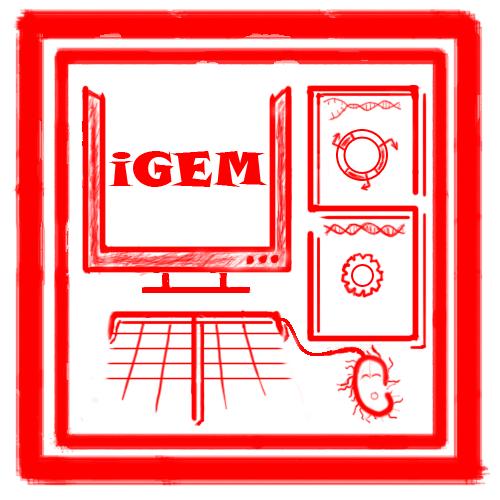|
|
Kinetic Parameters Identification
|
First of all, we shall clarify that, being dedicated to dry lab experiments, we naturally doesn't have as many incarnated Bio-Parts as usual wet labs do.
In wet lab experiment, kinetic parameters are notorious for their difficulties to be obtained quantitatively. To construct a well fabricated device, the kinetic parameters are crucial for an extensible part. When certain parts are placed in the network, certain biochemical reactions with holding kinetic parameters are introduced. To identify kinetic parameters of basic devices determines the extensibility of devices.
|
Model 2
is a subsystem of Model 3.
|
Here we put forward another feasible way to define dynamic parameters of biochemical reactions, and further characterization of single biobrick and combined bio-devices, in terms of chemical dynamics view.
|
- Data Sheet and Related Construction.
Note: each quantitative archive below should have at least one record documented in SI units.
- A pool of standard reactions should be constructed according to following suggested rules.
- (required) Reaction serial number
- (required) Clear characterazation of reacting substances, grouped by reactants and products.
- reactants' serial number, names and number of types
- products' serial number and names and number of types
- Finite division of reaction types (with unique serial numbers for each).
- (required) Reaction type (used for mathematical modeling, including Hill, Linear, etc.)
- (required) Parameters' names, values and number of types according to selected reaction type
- (optinal, default to be independent) Temperature dependence of parameters listed above, each described by an analytical function or quasi-continuous experimental data in deriative form
- (optional) Other reaction requirements
- physical conditions including reaction compartment, external magneitc field, lighting condition, etc.
- chemical conditional including PH, specific coexistence with other substances, etc.
- (optional) Notes for the reaction
- A pool of standard substances (applicable to any unit depictable by reaction types listed in the pool of reactions, including BioBricks, BioDevices, individual cell or even colony)
- (required) substance's serial number and name.
- (optional) substance's general physical properties, including molecular mass, magnetism, phase diagram, infrared spectra, etc.
- (optional) substance's general chemical properties, including chemical composition, hydrolysis constant, ionization constant, and the stability in conventional intermediate like air and distilled water, etc.
- (required) subtance's class (small molecule, DNA, mRNA, etc.), related reactions' serial numbers, status of the substance in that reaction (involved as reactant or product), etc.
- (required if type = "BioBrick" or "BioDevice") Standard requirement listed by partsregistry, including sequence length, coding sequence, etc.
- (required) Safety precausions and other notes of the substance.
|
Item Example
Reaction
|
Reaction Serial Number: ABCD0008RS
Reactant number: 2
Reactants: subs1, subs2
Product number: 2
Products: subs3, subs4
Reaction type: 3(e.g., defined to represent Hill interaction)
Term form: c0*x^2/(c1+c2*x^2)
Parameter numbers: 3
Parameter: c0, c1, c2
Time dependence: None
Chemical environment: 1,3 (e.g. 1 - dry, 3 - avoid direct light)
|
Substance
|
Substance Serial Number: MF9013DG
Substance Name: subs1
Molecular mass: 3270.45
Infrared spectra: http://ExternalLinkToTheData
Chemical Composition: C_{125}H_{282.3}O_{103}N_{48.2}:Fe_3
Type: S (e.g. defined as Small Molecule)
Related Reactions: ABCD0008RS/R, ABCD0092MQ/P
Safety: Poisonous at touch
|
|
Another Definition of Reaction Parameters
By constructing the two interwined database, we can easily retrieve chemical dynamics parameters, match reactions or substances, traverse possibly extended bio-network or reaction network. Above all, we can retrieve enough information to abstract the real, substential system to soundly built linear/nonlinear ODE array system, based on which, we can predict behavior, modify choices and make suggestions.
Though there does exist quite a lot of standard protocols and techniques depicting measurements to quantify bio-chemical reaction parameters under strictly defined reacting environment, the high cost and usually mediocre outcome still can hardly live up to prople's needs. Now assume the modeling has enough precision of simulation/identification, we can loose the strict requirements of reaction system and leave the addtional complexity originated from loosen conditions to the program, and choose experimental data from a much wider range of reactions to 'fit' the 'true' reaction parameters. And this is our basic idea to propose a new way to identify reaction parameters by means of system identification and reverse engineering.
- Choose a reaction network contaning the desired interaction parameters. Note that the reactants and products must exist in databse constructed above.
- Search substances to find all possible reactions in the bio-network.
- For each substance, every reaction will contribute none or one term of interaction at the right end of the ODE equation concerning this substance with respect to reaction's type recorded in reaction database.
- Build up the ODE array to fully describe the reaction network.
- Identify parameters of every term in the ODE array with accordance to the experimental data of the time course of the network's all substances' concentration. Algorithm might involve classical system identification and reverse engineering.
- The identified parameters, if fall in between acceptable error region after repeated identifications, can be accepted as a standard parameter of coressponding substance.
|
|
 Automatic Biological Circuits Design - Team Logo: wanna know more about the hinding metaphors and inspirations in this little red square? Click to check out how much fun this year's iGEM has brought us!
|
|
 Teaching Affair Office, USTC
Teaching Affair Office, USTC
|
|
 School of Life Sicences, USTC
School of Life Sicences, USTC
|
|

Foreign Affair Office, USTC
|
|

Graduate School, USTC
|
|
 School of Information Science and Technology, USTC
School of Information Science and Technology, USTC
|
|
 School for the Gifted Young, USTC
School for the Gifted Young, USTC
|
|

|